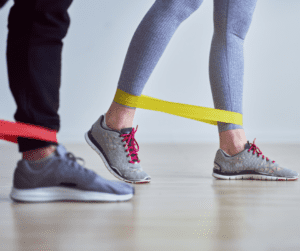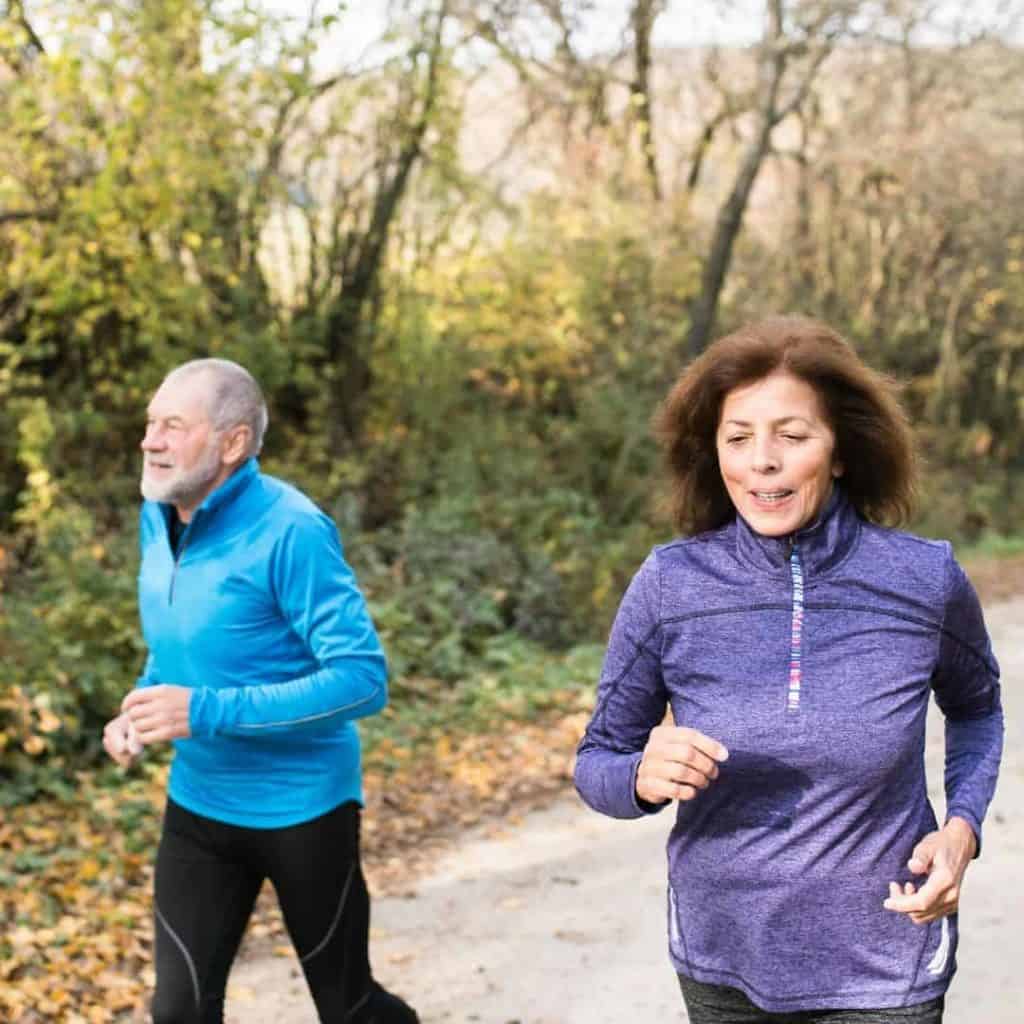We’ve all heard it… “Your knees don’t have enough cartilage left for you to continue running”, “You need to stick to low impact activities like swimming” or “Your love for running needs to come to a swift end”.
But does sacrificing the activities you love have to be the case? – just because you’ve got arthritis?
We get asked more often than not by runners if it’s still alright for them to run now that they have arthritis…
According to the latest science, you are able to run with arthritis, and contrary to popular belief, running is not bad for your joints. Studies indicate that running helps ease arthritis pain and stiffness.
Let’s have a look at a study conducted by the Osteoarthritis initiative. The researchers had a look at the different levels of arthritis in a group of people as well as their pain levels.
They then took a look at the same group of people four years later and it turns out that those who continued to run had no increase in their symptoms as shown on x-rays and what is even more noteworthy is that they had less pain than they did four years ago.
Now that we know that running is not bad for your arthritic joints (when done in a controlled and progressive manner), let’s dive into the impacts arthritis can have on your running…

What Impact Does Arthritis Have On Your Running?
Let’s be real, this does not mean everyone with arthritis will be able to run as fast as they once were able to, a lot of factors need to be taken into consideration. You could have arthritis of the knees, hips, or ankles and these all will have an impact on your running.
Did you know that there are more than 100 types of arthritis?
Let’s dig a bit deeper into the most common forms and how they impact your running.
Running With Osteoarthritis
Osteoarthritis (OA) commonly results from aging but can also be caused by overuse injuries (ie. continued overuse over time) or obesity. It’s the wear & tear that comes from your joints being overused.
The joints that are mostly affected are weight-bearing joints such as your spine, knees, hips, and feet. What happens is that your cartilage (your body’s shock absorber) begins to degenerate, which makes movement painful and is likely to worsen as your day gets along.
Osteoarthritis is a tricky one because, even though running will undeniably give you fantastic benefits like encouraging blood flow to your limbs, improved oxygen levels, improved muscle tone surrounding your joints, and a reduced load from your joints.

People with Osteoarthritis might find running on some days to be too high-impact and painful, which is why we suggest following a running training program that includes ongoing support, feedback, and adjustment with a particular focus on the correct type of strength training for Osteoarthritis, as well as advice on recovery. Recovery becomes even more important when someone has Osteoarthritis.
Knowing when to back off and what intensity to train at is VITAL.
Running With Rheumatoid Arthritis
Rheumatoid Arthritis (RA) is an autoimmune disease, this means that the body’s immune system is attacking the joints, which causes swelling, inflammation, and pain around the joints. It is likely to be at its worst first thing in the morning.
Combining exercises such as strength and conditioning with your running will strengthen the muscles around your joints which will, in turn, reduce pain, and adjusting your exercises according to how your body feels will help combat the effects of Rheumatoid Arthritis.
Running With Psoriatic Arthritis
Psoriatic Arthritis affects the joints and skin. Psoriasis causes parts of your skin to become patchy, burn, and itch. 1/3rd of people who suffer from Psoriasis will develop Psoriatic arthritis, which causes swelling in the fingers and toes.
Maintaining physical activity such as running will help you maintain your muscle strength and joint mobility which is what people with Psoriatic Arthritis need to manage their condition.
We are HUGE advocates of mobility work here at Coach Parry and have created a mobility flow that you can do at home. You can access the mobility flow by clicking here.
Running volume and frequency should be managed according to discomfort in affected joints – in this case, the feet.

Running With Gout
Gout is a well-known term used for a variety of conditions caused by a buildup of uric acid. This usually affects the feet, specifically your big toes, and then moves to joints throughout the body.
Uric acid is formed when purines (chemicals found in certain foods like red meat, seafood & beans) break down in your body.
Normally your body can rid itself of uric acid quite easily when you urinate but sometimes the body makes too much uric acid or isn’t able to excrete enough of it. This could happen because your kidneys aren’t eliminating it quickly enough.
Anyone who has experienced Gout will tell you that it causes severe pain and is not to be taken lightly.
One of the best ways to prevent “Gout attacks” is to run regularly. If left untreated Gout will erode and destroy your joints. Research shows that fat in the body carries more uric acid than muscle, therefore by reducing your body fat, you can reduce your uric acid levels in your blood.
Maintaining cardiovascular health through running is very important for people with Gout.
All of us are built differently and that means our bodies react to running in different ways. You may need to adapt your running routine but the reality of the situation is that keeping active is the best remedy for you.

Does Running With Arthritis Make It Worse?
We know arthritis is not caused by running, but there is still that worrisome voice in the back of your mind wondering… but can running worsen my arthritis?
By choosing to not run you can make your joints even stiffer and more painful. Keeping your surrounding tissue and muscles strong & mobile is critical in maintaining support for your joints.
It turns out that your body’s fantastic shock absorber- known as cartilage, enjoys the cyclical loading associated with running.
Let’s have a look at the different ways arthritis in your knees, hips, spine, and feet affects your running…
Running With Arthritis:
Arthritis In Your Knees
Running with arthritis in your knees means you need to respect your knees, it may sound unusual but it will ensure fewer chances of injuring yourself.
By respecting your knees we mean:

- Using a proper running training program.
- Correct biomechanics when running, which you can fix with strength training, or in extreme cases – gait retraining.
- Avoid shuffling while you run.
- Listening to your body, and knowing when it’s time to slow down.
- Strengthening the musculoskeletal structures around your knees so that the load from running is minimized.
Arthritis In Your Hips
One of the first things you will notice that happens to your hip with arthritis is that it becomes extremely stiff and inflexible. This will in turn make the body overcompensate, and place strain on other parts of your body.
To run with arthritis in your hips you will need to:
- Consistently do mobility exercises to open up your hips and gain movement back.
- Strengthen your hip structures such as glutes and pelvic stability.
- Strengthening the core will make a big impact as it changes the pelvic tilt and takes the pressure off the hip joint.
- Strengthen your leg muscles – hamstrings in particular.
- Add some cross-training into your exercise program.
Making sure you do the correct strength training is important. The good news is we’ve created a free strength training plan for runners that you can download by clicking here.

Arthritis In Your Feet
Running with arthritis in your feet means that you need to improve flexibility & mobility in your feet and ankles and strengthen the muscles supporting your lower limb and feet. This will all aid in preventing stiffness and inflammation.
Running safely with arthritic feet involves:
- Choosing the right footwear.
- Strengthening is important, foot core exercises are neglected, you need to work on the small intrinsic muscles in your feet.
- Ice and elevation after exercise, the cold will constrict blood vessels which will help reduce inflammation.
- It is vital to have the right pair of shoes for cushioning and support.
Arthritis In Your Spine
Spinal arthritis can cause a lot of discomfort and pain, it can reduce your ability to run if you don’t take the right precautions.
To run with arthritis in your spine:
- Stretch and warm-up, this will decrease your chance of sustaining an injury.
- Run on even terrain, this will help lessen your chances of falling.
- Listen to your body and know your limits.
So how do you ensure you keep running for years to come and that your arthritis doesn’t bring your running to an abrupt halt…

4 Tips To Safely Run With Arthritis
Here are the 4 things you can do that will have a positive impact on your arthritic joints that will ensure you can keep running for years to come:
Let’s dive into why each one is important:
Monitor your recovery
Our first and number one tip is RECOVERY. No matter your age or level of fitness, all runners need to recover.
Runners with arthritis need to take time to let their bodies recover according to their pain levels. Just remember – arthritis has affected your joint’s ability to recover from exercise, which means very often back-to-back runs can no longer be done (ie. runs done on consecutive days).
Although it may seem counterintuitive, positive milestones in running actually happen when you rest, not while you’re training. Your body needs to recover in order to absorb the work that you have done.
Always warm-up & cool down
Skipping your WARM-UP & COOL-DOWN will put your joints at a greater risk of strain and injury. Dynamic stretching is a great way to warm up before running as it increases your blood flow to your muscles and mimics the movement you will be doing.
Warm-ups activate the connections between your nerves and your muscles, this will result in your movement being more efficient as your range of flexibility will be increased.
Cool-downs gradually decrease your heart rate and begin the process of recovery. By gently stretching your muscles during your cool down you will bring your body back to its resting state.

Try out different terrains
There is not one specific TERRAIN that has been proven to be better for runners with arthritis, this is something that is subjective and needs to be tested for yourself.
Some runners find running off-road better for their pain levels, whilst some aim to limit the number of downhills on the route.
We have noticed that running on asphalt is particularly harder for people with Osteoarthritis compared to a trail. We suggest trying different terrains and finding what works best for you.
Include strength training
Strength training is so important when it comes to running with arthritis. By fitting strength training into your running program you will reap the benefits of increased muscle and joint strength and have fewer chances of getting injured during your runs.
What Is Vital About Strength Training With Osteoarthritis
- Technique. Technique. Technique. It’s not about what you are doing but rather the HOW that is more important! Because you have a limited range of motion, you need to modify some exercises to help.
- Progression of strength training, You can’t just jump into (excuse the pun) plyometrics. Structured progressive strength work is key to ensuring the strength training doesn’t exacerbate the Osteoarthritis.
Eg. we would never put lunges into a program for someone with Osteoarthritis, you can get the same effect with a squat and some glute work.
Strength training is in essence resistance training, it involves using your own body weight, or equipment like resistance bands and exercise machines to build muscle mass.
If you’ve made it this far you’re obviously the type of person who wants to keep running for many more years to come.
If you are, I think you’ll love our upcoming Faster Beyond 50 Masterclass.

Join us for a free online presentation of the…
The Faster Beyond 50 Masterclass
…and discover how you can run well (and faster) as you get older, without training more or harder than you currently are, all while avoiding injury.
If it feels like you’re training harder than ever but not running the paces you’d like to be running or if you’re constantly tired, fatigued or running in some sort of pain, then this is specifically for you.



Comments are closed.